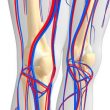Just when we were starting to understand how long dual antiplatelet therapy should be for our patients, JACC publishes this study where ticagrelor combined with aspirin significantly reduces relative and absolute events rate at long term, especially in patients with multivessel disease. The PEGASUS-TIMI 54 assessed the long-term benefits of two different doses of ticagrelor (60 mg or<a href="https://solaci.org/en/2018/03/21/new-study-shows-ticagrelor-aspirin-reduce-events-rate/" title="Read more" >...</a>
Complete Revascularization Is Beneficial in Acute MI with Cardiogenic Shock
Around half of all cases of ST-segment elevation acute myocardial infarction (STEMI) come alongside lesions in another vessel, for which the current strategy is complete revascularization in one or two steps. However, there are no large-scale studies analyzing patients who also present cardiogenic shock; we only have observational studies with inconclusive results influenced by several<a href="https://solaci.org/en/2018/03/16/complete-revascularization-is-beneficial-in-acute-mi-with-cardiogenic-shock/" title="Read more" >...</a>
What Is the Prognosis for Reinterventions in Critical Lower Limb Ischemia?
Infrapopliteal (below the knee, BTK) percutaneous transluminal angioplasty (PTA) has been acknowledged as a useful strategy in chronic critical limb ischemia (CLI), but artery calcification severity results in considerable restenosis. Repeat PTA and the management of trophic lesions help with wound healing. However, this conduct has not been extensively assessed. This study enrolled 152 patients (175 limbs)<a href="https://solaci.org/en/2018/03/14/what-is-the-prognosis-for-reinterventions-in-critical-lower-limb-ischemia/" title="Read more" >...</a>
Routine FFR/iFR Reclassifies Treatment Strategies in Half of Cases
Routine invasive physiology assessment at time of angiography reclassifies treatment strategies in a big number of patients with lesions in 2 or 3 vessels, according to the multicenter prospective study DEFINE REAL, recently published in JACC Cardiovascular Interventions. The information obtained by measuring fractional flow reserve (FFR) or instantaneous wave free ratio (iFR) made interventionists modify their original plans in<a href="https://solaci.org/en/2018/03/07/routine-ffr-ifr-reclassifies-treatment-strategies-in-half-of-cases/" title="Read more" >...</a>
These were the 5 most read scientific articles of February
1) The CULPRIT-SHOCK Study Is Finally Published in NEJM and It Is Bound to Change Guidelines During SOLACI’s coverage of the TCT 2017 Congress in Denver, Colorado, we already mentioned some of the outcomes of this study that has arrived to revolutionize clinical practice, given the differences between its results and those of the classic SHOCK trial, which has marked<a href="https://solaci.org/en/2018/03/01/these-were-the-5-most-read-scientific-articles-of-february/" title="Read more" >...</a>
Surprising Prognosis for Normal ACS
St elevation acute coronary syndromes are typically caused by thrombotic obstruction of a coronary artery due to ruptured atherosclerosis plaque. However, there is a significant number of patients with similar clinical presentations but no evidence of obstructive coronary artery disease (CAD). Read also: CTO in patients with acute myocardial infarction increases long term mortality. In general, patients without<a href="https://solaci.org/en/2018/03/01/surprising-prognosis-for-normal-acs/" title="Read more" >...</a>
Incomplete Revascularization Does Not Mean the Same Thing for All Patients
Several studies show that patients with multivessel lesions who undergo angioplasty with incomplete revascularization experience more events, including higher mortality, than a cohort of patients who have undergone complete revascularization. In most cases, the analysis was dichotomic (complete vs. incomplete revascularization), but more recent studies show that there may be a gradient, a continuum, in<a href="https://solaci.org/en/2018/02/14/incomplete-revascularization-does-not-mean-the-same-thing-for-all-patients/" title="Read more" >...</a>
The CULPRIT-SHOCK Study Is Finally Published in NEJM and It Is Bound to Change Guidelines
During SOLACI’s coverage of the TCT 2017 Congress in Denver, Colorado, we already mentioned some of the outcomes of this study that has arrived to revolutionize clinical practice, given the differences between its results and those of the classic SHOCK trial, which has marked for almost 20 years the treatment strategy for patients with infarction complicated<a href="https://solaci.org/en/2018/02/09/the-culprit-shock-study-is-finally-published-in-nejm-and-it-is-bound-to-change-guidelines/" title="Read more" >...</a>
The Importance of Knowing Which Conduits Will a Surgeon Use for Revascularization
Whether a second arterial conduit improves outcomes in patients undergoing myocardial revascularization surgery is and will remain unclear until the 10-year results of the ART (Arterial Revascularization Trial) are published. Consequently, arterial conduits other than the left internal thoracic artery are seldom used in daily practice. Using a database including 126 non-federal hospitals in California, researchers<a href="https://solaci.org/en/2018/01/30/the-importance-of-knowing-which-conduits-will-a-surgeon-use-for-revascularization/" title="Read more" >...</a>
The 9 most read scientific articles of 2017 in interventional cardiology
1) New High Blood Pressure Guidelines The wait is finally over: the high blood pressure guidelines that have been in the works for the past 3 years saw the light of day at the American Heart Association (AHA) 2017 Scientific Sessions. Read more 2) Nearly half of interventional cardiologists may have pre-cataract lesions This statement is based on eye<a href="https://solaci.org/en/2018/01/23/the-9-most-read-scientific-articles-of-2017-in-interventional-cardiology/" title="Read more" >...</a>









